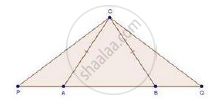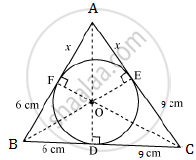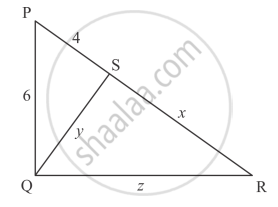Advertisements
Advertisements
प्रश्न
In an isosceles ΔABC, the base AB is produced both the ways to P and Q such that AP × BQ = AC2. Prove that ΔAPC ~ ΔBCQ.
उत्तर

Given: In ΔABC, CA = CB and AP × BQ = AC2
To prove: ΔAPC ~ ΔBCQ
Proof:
AP × BQ = AC2 [Given]
⇒ AP × BQ = AC × AC
⇒ AP × BQ = AC × BC [AC = BC given]
`rArr"AP"/"BC"="AC"/"BQ"` ......(i)
Since, CA = CB [Given]
Then, ∠CAB = ∠CBA …(ii) [Opposite angles to equal sides]
Now, ∠CAB + ∠CAP = 180° …(iii) [Linear pair of angles]
And, ∠CBA + ∠CBQ = 180° …(iv) [Linear pair of angles]
Compare equation (ii) (iii) & (iv)
∠CAP = ∠CBQ …(v)
In ΔAPC and ΔBCQ
∠CAP = ∠CBQ [From (v)]
`"AP"/"BC"="AC"/"BQ"` [From (i)]
Then, ΔAPC~ΔBCQ [By SAS similarity]
APPEARS IN
संबंधित प्रश्न
In the below figure, a triangle ABC is drawn to circumscribe a circle of radius 3 cm, such that the segments BD and DC are respectively of lengths 6 cm and 9 cm. If the area of Δ ABC is 54 cm2, then find the lengths of sides AB and AC.

In ∆ABC, P and Q are points on sides AB and AC respectively such that PQ || BC. If AP = 3 cm, PB = 5 cm and AC = 8 cm, find AQ.
Corresponding sides of two triangles are in the ratio 2 : 3. If the area of the smaller triangle is 48 cm2, determine the area of the larger triangle.
In each of the figures given below, an altitude is drawn to the hypotenuse by a right-angled triangle. The length of different line-segment are marked in each figure. Determine x, y, z in each case.

In a quadrilateral ABCD, ∠B = 90°. If AD2 = AB2 + BC2 + CD2 then prove that ∠ACD = 90°.
State SSS similarity criterion.
If ∆ABC and ∆DEF are similar triangles such that AB = 3 cm, BC = 2 cm, CA = 2.5 cm and EF = 4 cm, write the perimeter of ∆DEF.
Sides of two similar triangles are in the ratio 4 : 9. Areas of these triangles are in the ratio.
XY is drawn parallel to the base BC of a ∆ABC cutting AB at X and AC at Y. If AB = 4 BX and YC = 2 cm, then AY =
In triangles ABC and DEF, ∠A = ∠E = 40°, AB : ED = AC : EF and ∠F = 65°, then ∠B =
